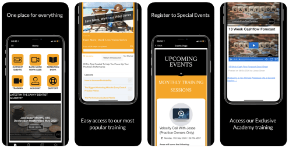The first step to mastering any skill is to first be aware and accept that there is still a lot of learning to do. This is especially true for people in leadership roles. They are so hardwired to believe that they need to have all the answers, be correct all the time and have the tendency to always be right. And this belief sets them up for miscommunication, failure and bad blood between them and their team members.
We see businesses and institutions failing all around us, and the reason is mostly quoted as ‘lack of leadership.’ And it is for this reason that I touch up on the topic of leadership every now and then because it could be at the core of the make or break of a company. So today we’d discuss some personality traits, technological interferences and communication barriers that can come in the way of a well performing leader.
Mindset
The first step to becoming a great leader is to adopt the right mindset. Leadership roles come with a lot of responsibility and expectations; and it is only natural for the person to feel overwhelmed and nervous. And these feelings affect performance and decision making processes. Leaders who keep a positive, supportive and focused mindset understand the difference between knowing the solutions and finding the solutions with the help and support of their team members. They don’t let their ego or negativity come in the way of taking the right steps and making goal-oriented decisions rather than self-oriented reactions.
Take Small Breaks
There are only so many minutes in an hour and so many hours in a day. And while you might think your motivation and desire to be the best at what you do is all the fuel and energy your body needs, it is not entirely true. There is only so much you can push your body to do before it starts fighting back; and when it does, it will take a toll on your ability to think rationally and logically.
You need to take mental and physical breaks from time to time in order to function optimally. And if you think you “don’t have the time for a break,” or “you can’t afford to take a break” then know that it will eventually lead to you working all the harder and longer to rectify the wrong decisions you took because you were exhausted. So see those small breaks as an investment in yourself and your business.
Map the Percentage of Time
So how do you really take time out for breaks? One very effective method is to map the percentage of time. Start by visually mapping your current role. What has your activity been like for the past week or so? Get a better understanding of where you have been spending your time. Now make a list of things that were either counterproductive or did not contribute in any way to your personal and professional growth?
You will be surprised by how much of that time is actually spent on your devices going through unimportant emails and social media posts. Research shows that the use of smartphones and other similar devices gives you a dopamine rush, which tempts you to keep on clicking and scrolling- resulting in wastage of valuable time.
So once you are done mapping out how you have been spending your time, break it up into percentages. What percentage of time was most effective? What percentage of time was least effective? What percentage of tasks will help you and your business grow? Now take a piece of paper and start mapping out your time on the things you want to focus more time on.
Delegating Effectively
A research by Harvard Business Review found that 50% of companies surveyed were concerned about their manager’s ability to delegate. And the number one reason why most of them were failing to delegate was the idea that ‘I can do it faster’ which they probably can, but that means you are spending more time in the business than on the business.
There are four levels of delegation which can easily be broken down into the commands or statements that leaders often use. So at the top is- ‘I need you to do this.’ It is a command where you expect your team member to know exactly what you want, how you want it and when you want it done.
The team member will not only lose motivation because he wasn’t involved in the process but will also be confused because he hasn’t really understood what is expected of him. And at the lowest level is ‘You know what? Don’t do it. I’m going to take it back.’ This is you giving up and getting frustrated and resorting to do it yourself. You not only end up overburdening yourself but also losing valuable resources because of your inability to delegate effectively.
And between these two levels are where productive delegation lies. It is you asking rather than telling. So level two is where you sit with your team member and say ‘how about we map out the process for completing this task?’ By doing this, you not only involve your team member but also outline what is expected of them. And then, with time, you could move it up to level three where you go ‘How about you map this out and then run it through me?’
Secrets of Effective Emailing
Emails are a common form of communication between leaders and team members. There are five expected outcomes for any email – to inform the team members of something, to collect information, to request a decision, an action or a meeting. The effective way to do this is to inform the other person what the nature of the email is in the subject line as well as clarify the purpose in the first few lines. Also keep them small and to the point- always!
Purpose Oriented Meetings
Meetings are often considered a waste of time, and they can be if they are not purpose oriented. I have dedicated an entire blog to conducting effective meetings. But the gist of it is to write down the goal of a meeting and focus on that goal only. For instance, if you are meeting for updates, then focus on reporting and check ins only rather than trying to solve problems. Similarly, if you are conducting a meeting for problem solving, or decision making or strategy development, then make the meeting about that purpose only.
This is not to say you need to conduct four meetings a week, you can have them all at the same time, but designate a specific amount of time for them, and then excuse the team members who are not part of the other issues.
So after going through the reporting, the receptionist should be allowed to get back to work, while the rest of the relevant team members continue with the next leg of the meeting.
As is evident, effective and impactful leadership starts with respecting and heeding to your own self. If you are not in tune with your body’s needs and demands, and waste valuable time on tasks that do not progress your own personal and professional growth, you will not be in the right mindset to delegate and lead effectively. Always prioritise yourself, because that’s where true success lies.
P.S. Whenever you’re ready …. here are 4 ways I can help you grow your dental practice:
- Grab a free chapter from my book “Retention – How to Plug the #1 Profit Leak in Your Dental Practice”
The book is the definitive guide to patient retention and how to use internal marketing to grow your practice – Click Here
2. Join the Savvy Dentist community and connect with dentists who are scaling their practice too
It’s our Facebook group where clever dentists learn to become commercially smart so that they have more patients, more profit and less stress. – Click Here
3. Attend a Practice Max Intensive live event
Our 2 day immersive events provide access to the latest entrepreneurial thinking and actionable strategies to drive your practice forward. You’ll leave with a game plan to take your results to the next level. If you’d like to join us, just send me a message with the word “Event and I’ll get you all the details! – Click here
4. Work with me and my team privately
If you’d like to work directly with me and my team to take your profit from 6 figures to 7 figures …. just send me a message with the word “Private”… tell me a little about your practice and what you would like to work on together, and I’ll get you all the details! – Click here






